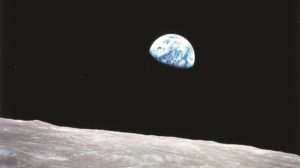Our solar system put on a spectacular performance back in April. There were several close alignments of the Moon and planets for those intrepid ones willing to head outside before sunrise. In May there was the total lunar eclipse, but if you missed it because of clouds, as I did, never fear — like your favorite ’80s rock band launching its summer tour, the dawn sky promises excitement in June.
Every morning before sunrise from June 16 to 27, the Moon and the planets Mercury, Venus, Mars, Jupiter, and Saturn will form a lovely arc from east to south. A lineup like this is a rare occurrence.
You know most of this already: The planets, including Earth, are in constant motion around the Sun. The closer a planet is to the Sun, the less time it takes to complete one orbit. Our own orbit takes 365 days, also known as one year. Venus, the next planet closer to the Sun, completes an orbit every 225 days. Mercury, the closest to the Sun, races around our star every 88 days.

Moving beyond Earth, the Martian year is 687 days long. Jupiter, the next planet out, completes an orbit every 12 Earth years. Saturn’s orbit spans 29 Earth years. Uranus and Neptune take even longer.
One effect of these differing orbital speeds is that the various planets come in and out of view at different points in our calendar year. Imagine a series of six interlocked rings that each rotate at different speeds. The smaller, innermost rings rotate more quickly than the larger, outermost rings. Now imagine that each ring has a single jewel set in it. Let’s give the third ring a blue sapphire; that’s Earth, third planet from the Sun. Mars, the Red Planet and the next ring out, gets a ruby. The other gems are up to you. Start the rings rotating and you’ll see the jewels move towards and away from each other, into and out of different alignments.
As you imagine this special alignment — five jewels lined up from the perspective of the blue sapphire — stop the rotating rings. There. That’s June 2022.
Of course, the actual planets don’t stop, but their apparent motion is slow enough that the alignment spans a few of our weeks.
June 24 will be the best morning to observe this alignment. Mercury, the hardest planet to spot, will be at its brightest and highest (which is still quite low in the east). And between June 16 and 27, the Moon will join the planets, enhancing the spectacle. But no need to wait. The window of opportunity for seeing this planetary alignment extends from early June through the end of the month. And for this alignment, the planets have nicely oriented themselves in order of their distance from the Sun, from Mercury in the east to Saturn in the south.
On the morning of your choice, head outside at least 45 minutes before sunrise. You’ll want to be somewhere with a clear view of the eastern horizon. An Outer Cape ocean beach would be the perfect spot. Start by finding brilliant blue-white Venus in the east. You can’t miss it. To its left and lower is much dimmer Mercury (especially if you choose a day before the 24th). It’s pink-white, which can be hard to discern against the pale predawn sky; be patient and keep slowly scanning to the left of and below Venus; eventually, you’ll catch it.
Now return to Venus and look to its right and higher. On June 24 you’ll find the Moon here; at other dates its location will vary. Continue to the right (south) and you’ll reach red Mars high in the east-southeast. Even higher and more to the south, Jupiter shines with a bright white-gold light. Finally, to Jupiter’s right and lower, but still high in the south, is yellow-gold Saturn. (Neptune and Uranus are here, too, but you’ll need a telescope to see them. They’re big planets but are so far away that they’re too faint for the unaided eye.)
Seeing these five planets together is a wonderful sight. Trace with your eye the arcing line that connects them. That’s the plane of the solar system in which all the planets orbit. The imaginary line continues past Mercury to the yellow glow on the eastern horizon that signals the rising Sun, the keystone of this celestial choreography. And if you’re able to observe more than once this month, you’ll see the planets change position slightly from night to night as the endless dance continues.
Check the weather forecasts and choose a morning that’s predicted to be clear. If clouds roll in unexpectedly, try again. This is a rare event that offers many opportunities for observation. Clear skies!



